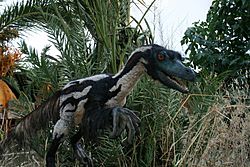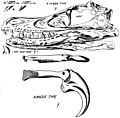Velociraptor facts for kids
Quick facts for kids VelociraptorTemporal range: Upper Cretaceous
|
|
|---|---|
 |
|
| Velociraptor. | |
| Scientific classification | |
| Kingdom: | |
| Class: | |
| Superorder: | |
| Order: | |
| Suborder: | |
| (unranked): | |
| Family: | |
| Genus: |
Velociraptor
|
Velociraptor was a small theropod dromaeosaur of the Upper Cretaceous, about 75–71 million years ago, and also a smaller relative of the famous Deinonychus.
Fossils of Velociraptor were first found in the Gobi Desert of Mongolia in 1922.
Contents
Description
Velociraptor had one sickle-shaped claw on its foot which measured 6.5 centimeters along its length, and a smaller one on each hand. Velociraptor was warm blooded and had feathers.
Fossils from China suggest that the whole clade had similar traits.
It was a slender, lightly built carnivore. It was about two meters long (nearly seven feet) and 0.62 meters tall at the hip, bigger than the common chimpanzee.
The skull of Velociraptor was rather elongated and grew up to 23 cm (9.1 in) long.
The teeth of Velociraptor were fairly equal in shape and had several denticles (serrations), each more strongly serrated on the back edge than the front.
History of discovery
During an American Museum of Natural History expedition to the Flaming Cliffs (Bayn Dzak or Bayanzag) of the Djadochta Formation, Gobi Desert, on 11 August 1923, Peter Kaisen discovered the first Velociraptor fossil known to science—a crushed but complete skull, associated with one of the raptorial second toe claws (AMNH 6515). In 1924, museum president Henry Fairfield Osborn designated the skull and claw (which he assumed to come from the hand) as the type specimen of his new genus, Velociraptor. This name is derived from the Latin words velox ('swift') and raptor ('robber' or 'plunderer') and refers to the animal's cursorial nature and carnivorous diet.
While North American teams were shut out of communist Mongolia during the Cold War, expeditions by Soviet and Polish scientists, in collaboration with Mongolian colleagues, recovered several more specimens of Velociraptor.
Between 1988 and 1990, a joint Chinese-Canadian team discovered Velociraptor remains in northern China. American scientists returned to Mongolia in 1990, and a joint Mongolian-American expedition to the Gobi, led by the American Museum of Natural History and the Mongolian Academy of Sciences, turned up several well-preserved skeletons.
In 1999, Rinchen Barsbold and Halszka Osmólska reported a juvenile Velociraptor specimen (GIN or IGM 100/2000), represented by a complete skeleton including the skull of a young individual. It was found at the Tugriken Shireh locality of the Djadochta Formation during the context of the Mongolian-Japanese Palaeontological Expeditions.
Feathers
In September 2007 researchers found quill knobs on the forearm of a Velociraptor found in Mongolia. These bumps on bird wing bones show where feathers anchor, and their presence on Velociraptor indicate it too had feathers.
Turner and colleagues interpreted the presence of feathers on Velociraptor as evidence that the ancestors of dromaeosaurids could fly, making Velociraptor and Deinonychus secondarily flightless. This idea has since been discarded; the unmodified forearms count against it. Therefore, the feathers in the ancestors of Velociraptor had another function. The feathers of the flightless Velociraptor may have been used for display, for covering their nests while brooding.
The majority view is that dinosaur feathers were primarily adaptations for temperature regulation, and that other uses came later.
Senses
Velociraptor was able to detect and hear a wide range of sound frequencies (2,368–3,965 Hz) and could track prey with ease as a result. It was an agile, swift predator, feeding on carrion during times of drought or famine, if in poor health, or depending on the animal's age.
Metabolism
Velociraptor was warm-blooded to some degree, as it required a significant amount of energy to hunt. Modern animals that possess feathery or furry coats, like Velociraptor did, tend to be warm-blooded, since these coverings function as insulation.
Species
Specimens from two species have been found:
- V. mongoliensis in Mongolia
- V. osmolskae in Inner Mongolia, China
In both cases the ecology of the time was dry, with sand dunes with occasional streams.
Media
Films such as Jurassic Park and some of The Land Before Time films helped make Velociraptor popular. However, the raptors in Jurassic Park were far larger than the real thing. They were the size of Deinonychus, a larger member of the same clade. The films also exaggerated its probable intelligence.
Relevant pages
Images for kids
-
The type skull of V. mongoliensis on display at the American Museum of Natural History
-
Mounted V. mongoliensis cast at Wyoming Dinosaur Center
-
V. mongoliensis restraining an oviraptorosaur with its sickle claws
See also
 In Spanish: Velociraptor para niños
In Spanish: Velociraptor para niños




















